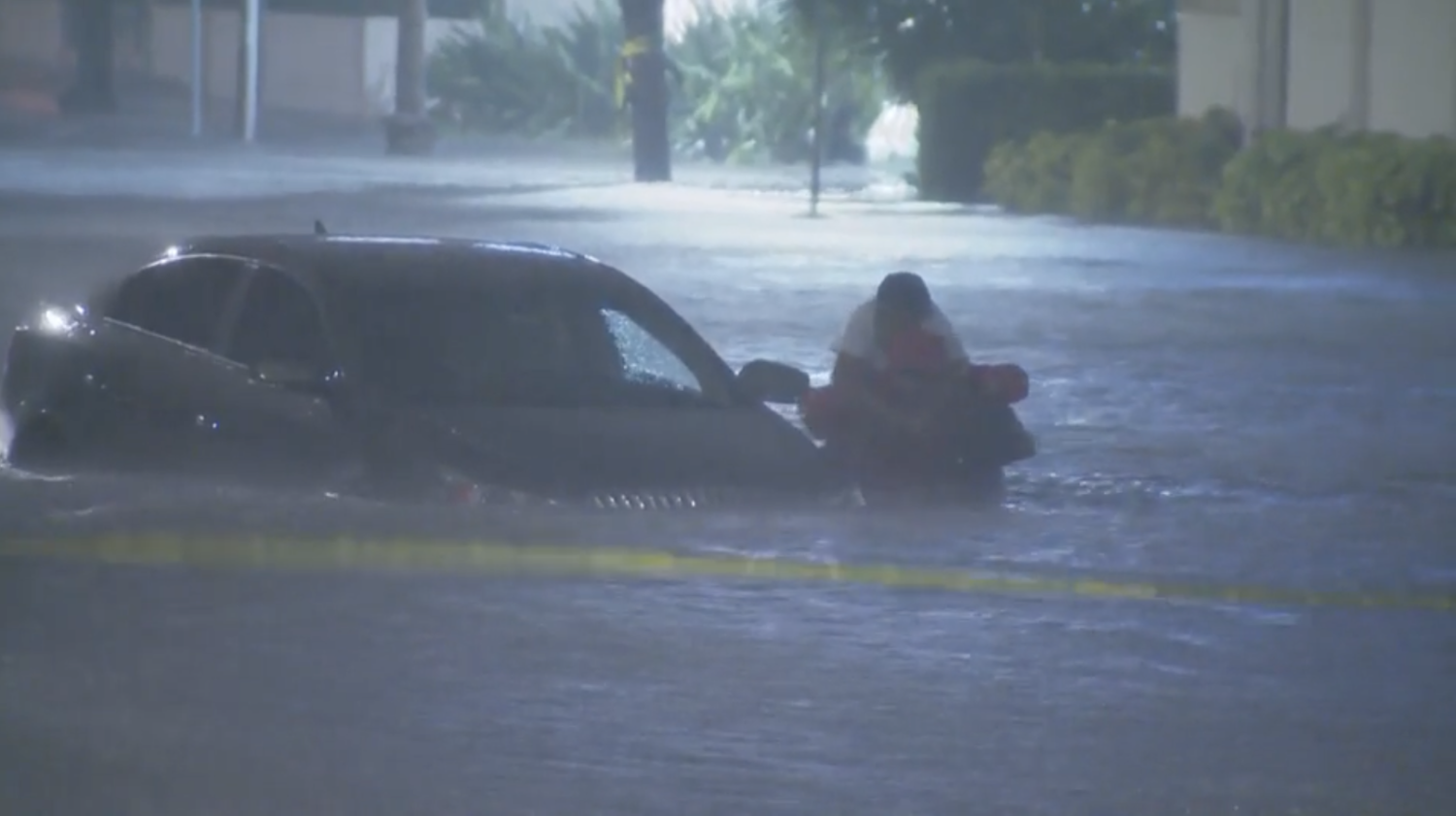Good morning, everyone. Tom Jones is on vacation, but the team at Poynter is keeping tabs on the latest media news and analysis. Here’s a quick rundown of what you need to know today.
Covering a hurricane in your hometown
As Florida officials issued evacuation orders for Hurricane Ian, local journalists hunkered down to document the storm.
Among them were Kate Cimini, a Florida investigative reporter for the USA Today Network, and Harriet Heithaus, a Naples Daily News arts and entertainment columnist. The two have been driving around Naples and Bonita Springs to survey the damage wrought by a category 4 hurricane that made landfall less than 50 miles north of them.
Poynter’s Angela Fu talked to them Thursday, and you can read her full story here.
Floodwaters pushed boats into the street and sucked houses away. A tornado near Heithaus’ condominium complex sent a carport toppling. At one point, the journalists had to pause their reporting to help Heithaus’ friend, who was stranded on her roof, along with her father, who has Alzheimer’s, and a neighbor with dementia.
“Part of your job, even as a journalist, is becoming something of a first responder,” Heithaus said. “It’s very unnerving, but the reason we’re all in this business, I think, is to help people.”
In addition to dealing with massive piles of debris and floodwaters, journalists working in the area have had to navigate power and cell service outages. WINK News, which is based in Fort Myers, had to go off the air Wednesday night after the first floor of its studio was flooded.
In a story posted on their website Wednesday, WINK News director of local news and content Tom Doerr said they would broadcast from their TV and radio stations once they had their generator running. Meanwhile, their journalists have continued to report on the storm’s devastation via social media.
The damage has been more widespread than anything Heithaus, who has lived in the area for 22 years, has seen before.
“I’ve been through three other hurricanes,” she said. “I’ve been through some bad hurricanes. This one was wider in scope than any of the others and had much more storm surge associated with it.”
A look at Ian’s destruction
Local and national news sites shared images of the aftermath of Hurricane Ian, and they’re all devastating. NPR has a collection that’s both big picture and small, showing a neighborhood churned to sticks and a couple with a boat in their apartment complex in Fort Myers. The Tampa Bay Times, which Poynter owns, has a team in Fort Myers. Their work shows rescue and the realization of what hit the state. USA Today Network’s collection shows the crumbled Sanibel Causeway, sunken boats and uprooted trees.
There’s more coverage that might help us understand just how bad things are in parts of Florida. CNN has a drone video from Fort Myers. The New York Times published a flood map to show the places hit the hardest. And The Washington Post published the video of a hurricane hunter who flew into Ian’s eye.
For perspectives from people in the communities hit hardest, many newsrooms turned to social media to republish photos, videos and first-hand accounts. Fort Myers’ News-Press has a collection from Twitter, TikTok and Instagram. Forbes published accounts from TikTok. And Poynter’s PolitiFact debunked a viral video thought to be a walrus seen in the flood waters. It was actually a seal in Chile.
‘A true hero’
A reporter for WESH 2 in Orlando rescued a woman who got stuck in floodwaters after attempting to drive through a flooded street. Afterwards, video of Tony Atkins carrying the woman on his back made its rounds on the Internet.
According to WESH, the nurse was on her way to work when her vehicle became stuck in high water near where the journalists were working.
In a later broadcast, Atkins told his anchor colleagues that he and his photographer had been turning a number of cars around for some time. The woman’s car got stuck. “Then I saw a hand come out. I heard ‘Help,’” Atkins said. He said he looked around for alligators, downed power lines, and even law enforcement to see if someone could rescue her.
“I just used caution and I just decided to slowly make my way out there and just help her out,” he said.

(Screenshot, WESH)
Atkins on Thursday morning tweeted an update for his followers. He received a message from the woman’s daughter thanking him. “We are so grateful for you!” she wrote, according to a screengrab of a text message to Atkins. “A true hero.”
Another look at the trust problem and how to fix it
There’s an issue within the issue of lack of trust in news – are journalists who produce the news and readers/viewers who consume it even on the same page about what’s problematic?
Rasmus Kleis Nielsen, whose Reuters Institute for the Study of Journalism at the University of Oxford has produced a series of studies on trust, summarized the work in a presentation Thursday to the World News Media Congress in Zaragoza, Spain. His seven-part Twitter thread is a tidy, short version of the institute’s much more detailed reports.
Nielsen begins with a good/bad/ugly series.
Good: News from established publishers is more credible to consumers than the rest of what’s on the Internet.
Bad: Negative perceptions are widespread. To many, journalists seem to manipulate what they report to serve a political agenda.
Ugly: “When we talk to journalists trying to address low trust and overcome negative perceptions, the things they focus on (e.g. transparency, audience engagement) are very different from what audiences focus on (relevance, familiarity, reputation for integrity).”
Even among those who are mostly skeptical, Nielsen continued, “many want to feel able to trust at least some news media.” The challenge is for editors and publishers to get past the usual answers – invest in reporting, separate news and opinion – and take on concerns like “presentation style, language (and) appearance.”
Most publishers we interview want trust, but when asked what they do to build it, many mostly mention things they are already doing anyway – e.g. invest in original reporting, seperate news/opinion etc. Many aren’t doing much specifically to build trust, so I ended w/some Qs 5/7 pic.twitter.com/1ucRpMAS2h
— Rasmus Kleis Nielsen (@rasmus_kleis) September 29, 2022
Nielsen expanded on those themes in a Poynter interview earlier this year. In general, news outlets need to stand for something, say so explicitly and show it in their work, he said. Brand, heritage and reputation carry clout.
The institute’s studies are international in scope and may mainly represent reactions to national as opposed to local news outlets. Listening tour exercises and the like would seem a more successful fit in a community news context.
United Facts of America
Poynter-owned PolitiFact just wrapped up its second annual United Facts of America, which featured PBS’ Judy Woodruff, Sen. Sheldon Whitehouse, NPR’s Eric Deggans and many other prominent experts in media, politics, technology and counterintelligence who convened to provide context and clarity on America’s most pressing issues leading up to the midterm elections — like inflation, privacy, climate change and misinformation.
Poynter’s coverage of this event included:
- Woodruff, Stirewalt discuss media’s role in fighting disinformation
- CNN’s Donie O’Sullivan sees firsthand how online mis- and disinformation affects people’s daily lives
- Spanish-language misinformation often goes unchecked, but individuals can help combat it
If you’d like to watch replays of the interviews and speakers, you can still register and watch recordings.
Today’s Poynter Report was written by Kristen Hare, Angela Fu, Rick Edmonds, Barbara Allen and Amaris Castillo.
Have feedback or a tip? Email Poynter senior media writer Tom Jones at tjones@poynter.org.
More resources for journalists
- Subscribe to Alma Matters — Poynter’s newsletter for college journalism educators.
- Time for a new job? Your future employer is looking for you on The Media Job Board — Powered by Poynter, Editor & Publisher and America’s Newspapers. Search now!
- Honor free press, democracy and the distinguished careers of Bob Woodward and Carl Bernstein at Poynter’s Bowtie Ball. The duo will receive the Poynter Medal for Lifetime Achievement in Journalism with Carl Bernstein accepting the honor in-person on Nov. 12, 2022, in Tampa, Florida. Get tickets.
The Poynter Report is our daily media newsletter. To have it delivered to your inbox Monday-Friday, sign up here.







